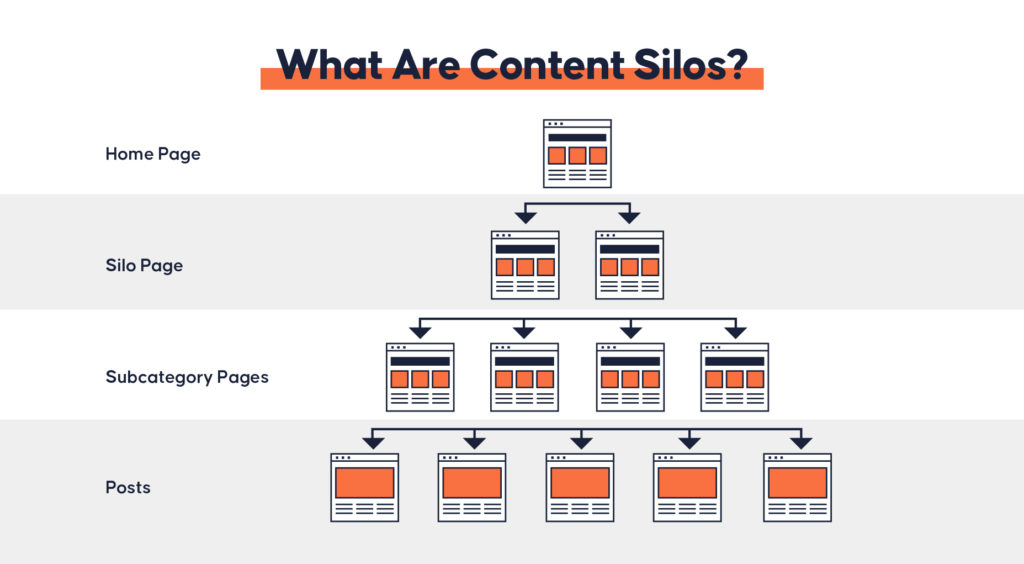Inquivix HQ
1-903, 18 Eonju-ro 146-gil,
Gangnam-gu, Seoul, Korea
06057

If you’ve been in the content marketing game for any length of time, you’ve undoubtedly heard of the concept of content silos. But what are they, and how can you use them to your advantage? In this post, we’ll take a look at what content silos are, why they’re important, and how to create and implement them effectively. So read on to learn more!
What Are Content Silos?
A content silo is a structure of website pages and blog posts that are all interconnected and support one another. The purpose of creating a silo structure is to give your readers a better experience by providing them with a logical flow of information and to improve your website’s SEO by establishing keyword themes.
The idea behind content silos is to create focused, content-rich pages on specific topics within your niche that all interlink with one another. This helps users easily find and navigate the the the information they are looking for while also improving site SEO by giving each page a dedicated focus on a keyword theme.

The primary goal of content silos is to make it easier for users to access and search for the information they need. In general, they help to improve efficiency by organizing data according to specific categories or keywords, allowing users to quickly find what they are looking for without having to sort through a large volume of data.
Why Are They Important for SEO and Website Traffic Growth?
Content silos are a critical component of any effective SEO strategy, as they help to improve both website traffic and search rankings. By organizing your website’s content into distinct topic clusters and optimizing each section for different keywords, you create a strong web hierarchy that is both search engine-friendly and user-friendly. This structural optimization increases visibility in SERPs, making it more likely that your site will be ranked highly for the selected keywords.
At the same time, well-organized content improves user experience by helping readers quickly find the information they are looking for. Well-maintained content silos help to increase audience engagement and drive continued traffic to your site over time. In short, content silos offer numerous benefits for SEO and website growth, making them a key component of any successful online strategy.
How Do You Create an Effective Content Silo Structure?
In order to ensure that your website is able to rank highly on search engine results pages, it is essential to create an effective content silo structure. By planning your website’s architecture in advance and grouping together related topics, you can make it easier for both search engines and visitors to find the information they need.

The key to creating a successful content silo structure is to start with a clear understanding of your website’s overall goals and then carefully map out the most logical way to group together related topics. With a little planning and attention to detail, you can create a content silo structure that will help your website achieve its full potential.
Devise a Content Strategy
A content strategy is a plan for how you will create and manage your content. It should answer the following questions: Who will create the content? What kind of content will you create? How often will you create new content? How will you distribute your content? How will you measure the success of your content?
A well-designed content strategy can help you save time, money, and effort by ensuring that your content is aligned with your business goals. It can also help you avoid duplication of effort and ensure that your content is consistent with your brand voice.
Creating a content strategy does not need to be complicated or time-consuming. Start by taking inventory of the kind of content you already have, then determine what gaps need to be filled. Once you know what kinds of content you need to create, you can develop a production schedule and assign responsibility for creating and maintaining each type of content.
Keyword Research
Keyword research is an essential part of any successful content marketing strategy. When done correctly, this type of research helps to identify the most relevant and valuable keywords for your website, allowing you to create engaging and effective content that appeals to your target audience.
In order to conduct effective keyword research, it is important to take a holistic approach, identifying and analyzing not only individual keywords but also multi-word phrases or “silos” that reflect patterns or groups of related words. By focusing on these silos instead of individual keywords, you can ensure that your content stays focused on the topics that matter most to users and that it has the potential to rank high on search engine results pages. By using keyword research as the cornerstone of your content strategy, you can create engaging and effective content that will help improve both traffic and conversions for your business.
Build Virtual and Physical Silos
There are two main types of content silos: virtual and physical. Virtual content silos are created by linking together related pages on your website through internal links. Physical content silos are created by grouping together related pages in a physical location, such as on a separate website or blog.
Both virtual and physical content silos have their advantages and disadvantages. Virtual content silos are generally easier to implement and maintain, but they can be less effective at improving SEO because they don’t physically group together related pages. Physical content silos tend to be more effective at improving SEO, but they can be more difficult to implement and maintain. Whichever approach you choose, make sure to carefully plan your content silos before implementing them on your site.
Integrate Your Blog
A content silo is a technique used to organize a website’s content in a way that makes it easy for search engines to find and rank. The goal of a content silo is to give each piece of content its own, distinct URL structure so that it can be easily found and indexed by search engines. One common way to achieve this is to integrate your blog into your website.
By adding blog posts to your website, you can create a series of internal links that will help search engines find and index your content. In addition, by tagging your blog posts with relevant keywords, you can ensure that they will show up in search results for those terms. By taking these steps, you can help improve your website’s visibility and traffic.
Interlinking
As anyone who has worked on a website knows, content can quickly become separated, with each page existing in isolation from the rest of the site. This can make it difficult for site visitors to navigate the site and find the information they are looking for. One way to overcome this problem is to interlink your content. By adding links between related pages, you can help users to discover new content and make it easier for them to find the information they need.
In addition, internal linking can also help to improve your website’s search engine optimization (SEO). By linking to other relevant pages on your site, you can create a network of connections that will help your website to rank higher in search results. As a result, interlinking is an essential tool for any website owner who wants to ensure that their content is both easy to find and engaging.
Common Mistakes in Using Content Silos on Websites or Blogs?
A content silo is a structure of website architecture designed to facilitate the flow of search engine traffic to specific pages on a website. It is an organizational strategy for grouping content together so that it is easy for readers to find related information. When done correctly, content silos can be an incredibly effective way to improve website traffic and search engine rankings. However, there are a few common mistakes that people make when using content silos.

First, they may create too many silos, which can make the website or blog feel fragmented and overwhelming. And also, they simply don’t create enough content to fill a silo, resulting in a wasted opportunity. Second, trying to stuff too many keywords into their content can actually hurt their ranking. They may stuff each silo with too much content, making it difficult for readers to find the information they need. Finally, they may fail to promote cross-linking between silos, which can prevent readers from discovering related content, making it difficult for search engines to index the content.
How Can You Avoid Them?
One of the best ways to avoid these common mistakes is to start with a clear content strategy. This should include setting goals for each silo, planning how much content to create and promote, and creating a cohesive structure that encourages readers to explore related topics. Additionally, it’s important to build strong partnerships with other bloggers or websites within your niche to promote your content and increase your domain authority.
Silos are a powerful tool for content marketers, but they must be used properly in order to yield the best results. By starting with a clear strategy and focusing on promoting cross-linking between silos, you can avoid common mistakes that can hamper your content marketing efforts.
How Do You Know If Your Website’s Content Silo Structure Is Effective?
There is no simple answer to this question, as the effectiveness of a website’s content silo structure depends on multiple factors. Some key considerations include the level of competition in your industry, the number of keywords you are targeting, and the overall quality of your content. Additionally, it is important to pay attention to user engagement metrics such as bounce rates, time on site, and the number of page views per visit.

Finally, keeping an eye on your search engine rankings can help you to evaluate how well your content silos are performing over time. Overall, there is no single indicator that can tell you definitively whether or not your website’s content silo strategy is successful; rather, you must take a holistic approach and continually monitor and adjust your tactics as needed.
Conclusion
By understanding the basics of content silos and using them properly, you can create a website that is easier to navigate for both your visitors and the search engines. You’ll also be able to provide your readers with the information they need in a way that is easy for them to find and understand. Have you tried creating a content silo structure on your website?
Now that you understand content silos and how to use them, it’s time to put your knowledge into practice. If you need help getting started, contact the SEO experts at Inquivix. We can help you create a content silo structure for your website that will improve your SEO and help you attract more visitors. Thank you for reading!
